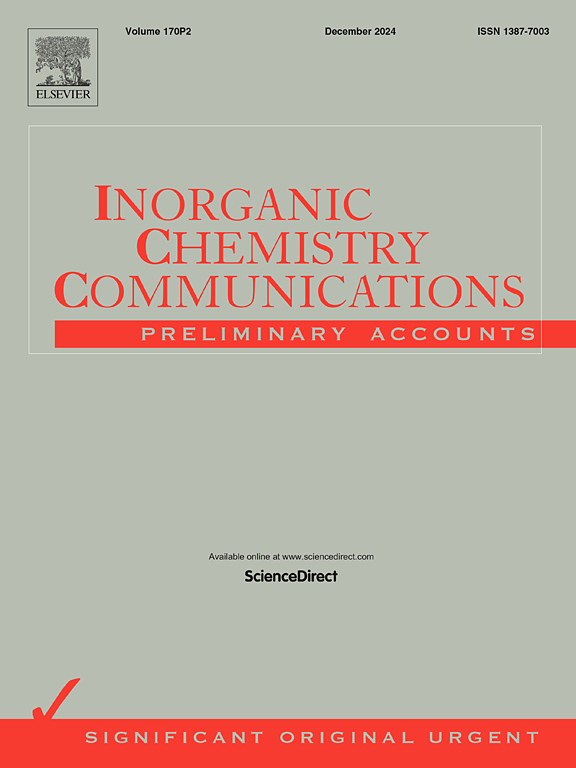A novel synthetic polymer platform for the eco-friendly fabrication of magnetic iron oxide nanoparticles as targeted drug delivery agents in cancer therapy
IF 4.4
3区 化学
Q1 CHEMISTRY, INORGANIC & NUCLEAR
引用次数: 0
Abstract
5-Fluorouracil (5-FU), a potent and widely used chemotherapeutic agent for breast cancer, faces limitations due to its cumulative dose-dependent cardiotoxicity. To address this challenge, we have developed a novel drug delivery system based on the environmentally friendly synthesis of magnetic iron oxide nanoparticles (Fe3O4 NPs). In this study, we successfully synthesized Fe3O4@GL-PEG-5-FU-NPs as an efficient nanocarrier for targeted drug delivery. These nanocomposites were comprehensively characterized to assess their morphology, composition, and chemical structure. Antibacterial studies conducted at concentrations ranging from 50 to 100 μg/mL demonstrated significant inhibition of bacterial growth, primarily attributed to the generation of reactive oxygen species (ROS). Additionally, an IC50 value of 25.12 μg/mL in human red blood cells highlighted the strong anti-inflammatory potential of the Fe3O4@GL-PEG-5-FU-NPs. These findings suggest their suitability as anti-inflammatory agents. Cytotoxicity assays further revealed that the nanocomposites exhibited dose-dependent anticancer activity against various human cancer cell lines, with particularly potent cytotoxicity against MCF-7 breast cancer cells (IC50 = 10.5 μg/mL). The multifunctionality of Fe3O4@GL-PEG-5-FU-NPs–encompassing antibacterial, anti-inflammatory, and anticancer effects presents a promising avenue for further research. Overall, this study enhances our understanding of nanoscale drug delivery systems and highlights the potential of nanotechnology in advancing pharmaceutical applications.

一种新型的合成聚合物平台,用于环保制造磁性氧化铁纳米颗粒作为癌症治疗中的靶向药物递送剂
5-氟尿嘧啶(5-FU)是一种广泛应用于乳腺癌的有效化疗药物,由于其累积剂量依赖性心脏毒性而面临局限性。为了解决这一挑战,我们开发了一种基于环保合成磁性氧化铁纳米颗粒(Fe3O4 NPs)的新型药物递送系统。在这项研究中,我们成功地合成了Fe3O4@GL-PEG-5-FU-NPs作为一种高效的靶向药物递送纳米载体。对这些纳米复合材料进行了全面表征,以评估其形态、组成和化学结构。在50 - 100 μg/mL浓度范围内进行的抗菌研究表明,其对细菌生长有显著的抑制作用,这主要归因于活性氧(ROS)的产生。此外,在人红细胞中的IC50值为25.12 μg/mL,表明Fe3O4@GL-PEG-5-FU-NPs具有很强的抗炎潜力。这些发现表明它们作为抗炎剂的适用性。细胞毒性实验进一步表明,纳米复合材料对多种人类癌细胞具有剂量依赖性的抗肿瘤活性,对MCF-7乳腺癌细胞具有特别强的细胞毒性(IC50 = 10.5 μg/mL)。Fe3O4@GL-PEG-5-FU-NPs -包括抗菌,抗炎和抗癌作用的多功能性为进一步研究提供了一个有希望的途径。总的来说,这项研究增强了我们对纳米级药物传递系统的理解,并突出了纳米技术在推进制药应用方面的潜力。
本文章由计算机程序翻译,如有差异,请以英文原文为准。
求助全文
约1分钟内获得全文
求助全文
来源期刊

Inorganic Chemistry Communications
化学-无机化学与核化学
CiteScore
5.50
自引率
7.90%
发文量
1013
审稿时长
53 days
期刊介绍:
Launched in January 1998, Inorganic Chemistry Communications is an international journal dedicated to the rapid publication of short communications in the major areas of inorganic, organometallic and supramolecular chemistry. Topics include synthetic and reaction chemistry, kinetics and mechanisms of reactions, bioinorganic chemistry, photochemistry and the use of metal and organometallic compounds in stoichiometric and catalytic synthesis or organic compounds.
 求助内容:
求助内容: 应助结果提醒方式:
应助结果提醒方式:


